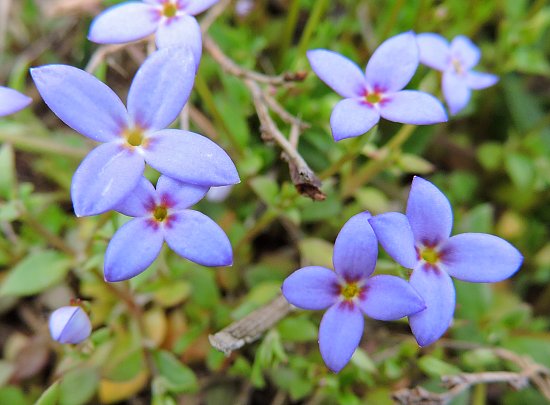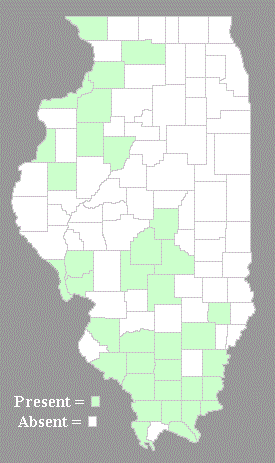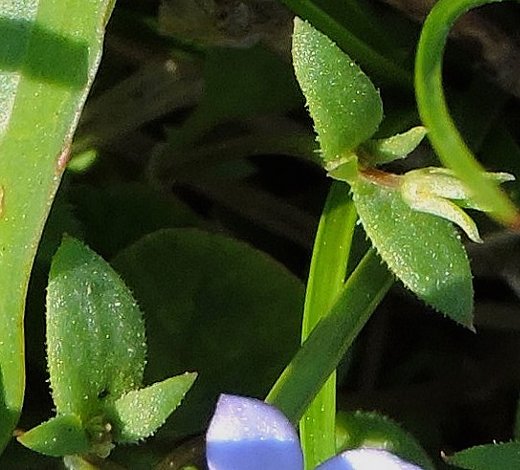Small Bluets
Houstonia pusilla
Madder family (Rubiaceae)
Houstonia pusilla
Madder family (Rubiaceae)
Description:
This tiny plant is a herbaceous winter annual that forms a tiny rosette
of basal leaves; this rosette persists through the winter. During the
spring, this plant bolts, forming a leafy stem that occasionally
branches. At maturity, it is typically only 2" (5 cm.) tall, although
under moist fertile conditions it can become taller. The
central stem and any lateral stems are light green to reddish brown,
4-angled, glabrous to appressed-hairy, and erect to ascending. A small
number of widely spreading opposite leaves occur along these short stems. The
leaves are 2–8 mm. (0.1–0.33") long and about one-third to one-half as
much across; they are ovate, lanceolate, or elliptic in shape, tapering
to
acute tips. The margins of the leaves are toothless and ciliate.

The upper and lower leaf surfaces are medium green and glabrous to sparsely pubescent. The leaves are sessile or they have very short petioles. Solitary pedicelled flowers often develop from the axils of the middle to upper leaves. Individual flowers are 6–9 mm. (0.25–0.33") across, consisting of a light to medium blue-violet corolla with 4 widely spreading lobes, a short-tubular calyx with 4 narrowly lanceolate lobes, 4 inserted stamens, and a pistil with a single inserted style. The lobes of the corolla are elliptic to broadly elliptic in shape, tapering to acute tips; there are reddish markings near the base of each lobe. The corolla is narrowly tubular below the lobes with a narrow upper opening. The calyx of each flower is light green to reddish brown and glabrous to sparsely pubescent. The narrow lobes of the calyx can
extend from about one-half to nearly the entire length
of the corolla (but see the Comments section below). The pedicels of
the
flowers are 6–39 mm. (0.25–1.5") in length. The blooming period occurs
from early to mid-spring, lasting about 1 month. Afterwards, the
flowers are replaced by seed capsules; these capsules are 2–4 mm. (0.10–0.20")
across. Each capsule contains a few to several tiny seeds; individual
seeds are globoid in shape, pitted along one side, and dark-colored.
The root system consists of a weak taproot. This plant spreads by
reseeding itself. It sometimes forms colonies of plants.
the calyx can
extend from about one-half to nearly the entire length
of the corolla (but see the Comments section below). The pedicels of
the
flowers are 6–39 mm. (0.25–1.5") in length. The blooming period occurs
from early to mid-spring, lasting about 1 month. Afterwards, the
flowers are replaced by seed capsules; these capsules are 2–4 mm. (0.10–0.20")
across. Each capsule contains a few to several tiny seeds; individual
seeds are globoid in shape, pitted along one side, and dark-colored.
The root system consists of a weak taproot. This plant spreads by
reseeding itself. It sometimes forms colonies of plants.
Cultivation: The preference is full sun, moist to dry-mesic conditions, and a barren soil containing rocky material, sand, or clay. This tiny plant prefers open areas with sparse low ground vegetation. The seeds should be scattered across the ground during the summer or early autumn.
Range & Habitat: The native Small Bluets (Houstonia pusilla) occurs occasionally in southern and western Illinois. Habitats include hill prairies, sandstone glades, open rocky woodlands, rocky stream valleys that are sunny, pastures, abandoned fields, roadsides, and lawns. Small Bluets is found in both higher quality natural areas and disturbed areas. Occasional wildfires are probably beneficial to establishing populations of this plant by reducing competition from other ground vegetation.
Faunal Associations: Information about floral-faunal relationships for this tiny plant is scarce. The small flowers are probably pollinated by small bees and possibly bee flies. Other bluets (Houstonia spp.) are often visited by little carpenter bees (Ceratina spp.) and Halictid bees. The larvae of a small day-flying moth, the Spotted Thyris (Thyris maculata), feeds on the leaves of bluets; the larvae roll the edges of leaves around themselves.
Photographic Location: A disturbed grassy area in Fayette County, Illinois. The photographs were taken by Keith Horn (Copyright © 2018).

Comments: This tiny plant can be overlooked because of its size, although it is more showy when it occurs in colonies while the flowers are in bloom. In disturbed areas, Small Bluets (Houstonia pusilla) often occurs with mouse-eared chickweed (Cerastium spp.), speedwell (Veronica spp.), and other small weedy plants. This is one of the earliest native plants to bloom during the spring. Some botanical taxonomists prefer to make a distinction between Houstonia pusilla (Small Bluets) and Houstonia crassifolia (Tiny Bluets), although the majority of them at the present time do not. Rightly or wrongly, I have lumped them together here, and this is reflected in the state distribution map. According to Mohlenbrock (2014), the calyx teeth of Houstonia pusilla extend to about two-thirds of the length of the corolla tube of the flower, while the calyx teeth of Houstonia crassifolia extend to nearly the entire length of the corolla tube of the flower. By this distinction, the photographed plants here are Houstonia pusilla. A scientific synonym of Small Bluets is Hedyotis pusilla.

The upper and lower leaf surfaces are medium green and glabrous to sparsely pubescent. The leaves are sessile or they have very short petioles. Solitary pedicelled flowers often develop from the axils of the middle to upper leaves. Individual flowers are 6–9 mm. (0.25–0.33") across, consisting of a light to medium blue-violet corolla with 4 widely spreading lobes, a short-tubular calyx with 4 narrowly lanceolate lobes, 4 inserted stamens, and a pistil with a single inserted style. The lobes of the corolla are elliptic to broadly elliptic in shape, tapering to acute tips; there are reddish markings near the base of each lobe. The corolla is narrowly tubular below the lobes with a narrow upper opening. The calyx of each flower is light green to reddish brown and glabrous to sparsely pubescent. The narrow lobes of
 the calyx can
extend from about one-half to nearly the entire length
of the corolla (but see the Comments section below). The pedicels of
the
flowers are 6–39 mm. (0.25–1.5") in length. The blooming period occurs
from early to mid-spring, lasting about 1 month. Afterwards, the
flowers are replaced by seed capsules; these capsules are 2–4 mm. (0.10–0.20")
across. Each capsule contains a few to several tiny seeds; individual
seeds are globoid in shape, pitted along one side, and dark-colored.
The root system consists of a weak taproot. This plant spreads by
reseeding itself. It sometimes forms colonies of plants.
the calyx can
extend from about one-half to nearly the entire length
of the corolla (but see the Comments section below). The pedicels of
the
flowers are 6–39 mm. (0.25–1.5") in length. The blooming period occurs
from early to mid-spring, lasting about 1 month. Afterwards, the
flowers are replaced by seed capsules; these capsules are 2–4 mm. (0.10–0.20")
across. Each capsule contains a few to several tiny seeds; individual
seeds are globoid in shape, pitted along one side, and dark-colored.
The root system consists of a weak taproot. This plant spreads by
reseeding itself. It sometimes forms colonies of plants.Cultivation: The preference is full sun, moist to dry-mesic conditions, and a barren soil containing rocky material, sand, or clay. This tiny plant prefers open areas with sparse low ground vegetation. The seeds should be scattered across the ground during the summer or early autumn.
Range & Habitat: The native Small Bluets (Houstonia pusilla) occurs occasionally in southern and western Illinois. Habitats include hill prairies, sandstone glades, open rocky woodlands, rocky stream valleys that are sunny, pastures, abandoned fields, roadsides, and lawns. Small Bluets is found in both higher quality natural areas and disturbed areas. Occasional wildfires are probably beneficial to establishing populations of this plant by reducing competition from other ground vegetation.
Faunal Associations: Information about floral-faunal relationships for this tiny plant is scarce. The small flowers are probably pollinated by small bees and possibly bee flies. Other bluets (Houstonia spp.) are often visited by little carpenter bees (Ceratina spp.) and Halictid bees. The larvae of a small day-flying moth, the Spotted Thyris (Thyris maculata), feeds on the leaves of bluets; the larvae roll the edges of leaves around themselves.
Photographic Location: A disturbed grassy area in Fayette County, Illinois. The photographs were taken by Keith Horn (Copyright © 2018).

Comments: This tiny plant can be overlooked because of its size, although it is more showy when it occurs in colonies while the flowers are in bloom. In disturbed areas, Small Bluets (Houstonia pusilla) often occurs with mouse-eared chickweed (Cerastium spp.), speedwell (Veronica spp.), and other small weedy plants. This is one of the earliest native plants to bloom during the spring. Some botanical taxonomists prefer to make a distinction between Houstonia pusilla (Small Bluets) and Houstonia crassifolia (Tiny Bluets), although the majority of them at the present time do not. Rightly or wrongly, I have lumped them together here, and this is reflected in the state distribution map. According to Mohlenbrock (2014), the calyx teeth of Houstonia pusilla extend to about two-thirds of the length of the corolla tube of the flower, while the calyx teeth of Houstonia crassifolia extend to nearly the entire length of the corolla tube of the flower. By this distinction, the photographed plants here are Houstonia pusilla. A scientific synonym of Small Bluets is Hedyotis pusilla.